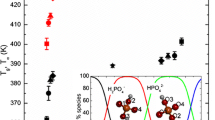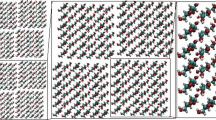ABSTRACT
Purpose
The work aims at investigating the correlation of water sorption potential with different measures of molecular mobility in an annealed amorphous model compound (trehalose).
Methods
Amorphous trehalose, prepared by freeze-drying, was annealed at 100°C (17°C < T g) for up to 120 h. Global molecular mobility was studied using a broadband dielectric spectrometer in the frequency range of 106–10−2 Hz. Enthalpic recovery was measured by differential scanning calorimetry and water sorption profiles were obtained using an automated vapor sorption balance.
Results
As a function of annealing time, there was an increase, both in average α-relaxation time and enthalpic recovery and a decrease in the amount of sorbed water. A strong linear correlation was observed between the water sorption potential and the dielectric relaxation time, indicating a common underlying mechanism of the effect of annealing time on these properties. Enthalpic recovery, which is widely used as a measure of structural relaxation, did not correlate well with the extent of water sorption.
Conclusions
The α-relaxation time can be used as a predictor of the water sorption potential of amorphous trehalose. It will be of interest and value to develop such predictive models for other amorphous compounds of pharmaceutical interest.








Similar content being viewed by others
REFERENCES
Nagapudi K, Jona J. Amorphous active pharmaceutical ingredients in preclinical studies: preparation, characterization, and formulation. Curr Bioact Compd. 2008;4:213–24.
Amidon GL, Lennernaes H, Shah VP, Crison JR. A theoretical basis for a biopharmaceutic drug classification: the correlation of in vitro drug product dissolution and in vivo bioavailability. Pharm Res. 1995;12:413–20.
Hancock BC, Zografi G. Characteristics and significance of the amorphous state in pharmaceutical systems. J Pharm Sci. 1997;86:1–12.
Craig DQM, Royall PG, Kett VL, Hopton ML. The relevance of the amorphous state to pharmaceutical dosage forms: glassy drugs and freeze dried systems. Int J Pharm. 1999;179:179–207.
Murdande SB, Pikal MJ, Shanker RM, Bogner RH. Solubility Advantage of Amorphous Pharmaceuticals: I. A Thermodynamic Analysis. J Pharm Sci. 2010;99:1254–64.
Murdande SB, Pikal MJ, Shanker RM, Bogner RH. Solubility advantage of amorphous pharmaceuticals: II. Application of quantitative thermodynamic relationships for prediction of solubility enhancement in structurally diverse insoluble pharmaceuticals. Pharm Res. 2010;27:2704–14.
Hallbrucker A, Mayer E, Johari GP. Glass transition in pressure-amorphized hexagonal ice. A comparison with amorphous forms made from the vapor and liquid. J Phys Chem. 1989;93:7751–2.
Hancock BC, Zografi G. The relationship between the glass transition temperature and the water content of amorphous pharmaceutical solids. Pharm Res. 1994;11:471–7.
Andronis V, Yoshioka M, Zografi G. Effects of sorbed water on the crystallization of indomethacin from the amorphous state. J Pharm Sci. 1997;86:346–51.
Yoshioka S, Aso Y. Correlations between molecular mobility and chemical stability during storage of amorphous pharmaceuticals. J Pharm Sci. 2007;96:960–81.
Chan AH, Paul DR. Influence of history on the gas sorption, thermal, and mechanical properties of glassy polycarbonate. J Appl Polym Sci. 1979;24:1539–50.
Chan AH, Paul DR. Effect of sub-Tg annealing on gas transport in polycarbonate. J Appl Polym Sci. 1980;25:971–4.
Surana R, Pyne A, Suryanarayanan R. Effect of aging on the physical properties of amorphous trehalose. Pharm Res. 2004;21:867–74.
Andronis V, Zografi G. Crystal nucleation and growth of indomethacin polymorphs from the amorphous state. J Non-Cryst Solids. 2000;271:236–48.
Li Y, Han J, Zhang GGZ, Grant DJW, Suryanarayanan R. In situ dehydration of carbamazepine dihydrate: a novel technique to prepare amorphous anhydrous carbamazepine. Pharm Dev Technol. 2000;5:257–66.
Pyne A, Surana R, Suryanarayanan R. Crystallization of mannitol below Tg’ during freeze-drying in binary and ternary aqueous systems. Pharm Res. 2002;19:901–8.
Angell CA, Ngai KL, McKenna GB, McMillan PF, Martin SW. Relaxation in glassforming liquids and amorphous solids. J Appl Phys. 2000;88:3113–57.
Alegría A, Goitiandia L, Tellería I, Colmenero J. Dielectric relaxation and physical aging in polar glassy polymers. J Non-Cryst Solids. 1991;131–133:457–61.
Alegría A, Goitiandía L, Tellería I, Colmenero J. α-relaxation in the glass-transition range of amorphous polymers. 2. Influence of physical aging on the dielectric relaxation. Macromolecules. 1997;30:3881–7.
Bhardwaj SP, Suryanarayanan R. Subtraction of DC conductivity and annealing: approaches to identify Johari-Goldstein relaxation in amorphous trehalose. Mol Pharm. 2011;8:1416–22.
Surana R, Pyne A, Rani M, Suryanarayanan R. Measurement of enthalpic relaxation by differential scanning calorimetry-effect of experimental conditions. Thermochim Acta. 2005;433:173–82.
Bhardwaj SP, Suryanarayanan R. Use of dielectric spectroscopy to monitor molecular mobility in glassy and supercooled trehalose. J Phys Chem B. 2012;116:11728–36.
Cicerone MT, Ediger MD. Enhanced translation of probe molecules in supercooled o-terphenyl: signature of spatially heterogeneous dynamics? J Chem Phys. 1996;104:7210–8.
Cicerone MT, Blackburn FR, Ediger MD. Anomalous diffusion of probe molecules in polystyrene: evidence for spatially heterogeneous segmental dynamics. Macromolecules. 1995;28:8224–32.
Cicerone MT, Wagner PA, Ediger MD. Translational diffusion on heterogeneous lattices: a model for dynamics in glass forming materials. J Phys Chem B. 1997;101:8727–34.
ACKNOWLEDGMENTS AND DISCLOSURES
We are grateful to Brad L. Givot (3M, St. Paul, MN) for all his help in the dielectric measurements and 3M (St. Paul, MN) for providing us access to the dielectric spectrometer. We thank Vishard Ragoonan, Ph.D. and Khushboo Kothari for their comments. Partial support was provided by the William and Mildred Peters Endowment Fund.
Author information
Authors and Affiliations
Corresponding author
Rights and permissions
About this article
Cite this article
Bhardwaj, S.P., Suryanarayanan, R. Molecular Mobility as a Predictor of the Water Sorption by Annealed Amorphous Trehalose. Pharm Res 30, 714–720 (2013). https://doi.org/10.1007/s11095-012-0910-6
Received:
Accepted:
Published:
Issue Date:
DOI: https://doi.org/10.1007/s11095-012-0910-6




